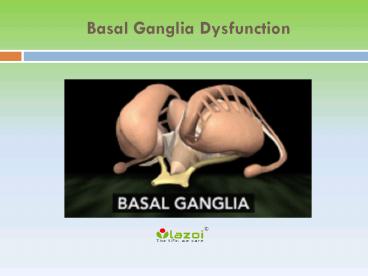Basal ganglia dysfunction: What you need to know - PowerPoint PPT Presentation
Title:
Basal ganglia dysfunction: What you need to know
Description:
Basal ganglia disease refers to a group of physical dysfunctions that occur when the group of nuclei in the brain known as the basal ganglia fail to properly initiate movements. – PowerPoint PPT presentation
Number of Views:55
Title: Basal ganglia dysfunction: What you need to know
1
Basal Ganglia Dysfunction
2
Basal Ganglia Dysfunction
- The basal ganglia (or basal nuclei) are a group
of nuclei of varied origin in the brains of
vertebrates that act as a cohesive functional
unit. They are situated at the base of the
forebrain and are strongly connected with the
cerebral cortex, thalamus, and other brain
areas. Basal ganglia disease refers to a group
of physical dysfunctions that occur when the
group of nuclei in the brain known as the basal
ganglia fail to properly initiate
movements. Conditions that cause injury to the
brain can damage the basal ganglia include - Carbon monoxide poisoning
- Drug overdose
- Head injury
- Liver disease
- Infection
3
Basal Ganglia Dysfunction
Continue
- Metabolic problems
- Multiple Sclerosis
- Poisoning with copper, manganese, or other heavy
metals - Side effects of certain medications
- Stroke
- Tumours
- Brain disorders associated with basalganglia
dysfunction include - Dystonia
- Huntington's disease
- Parkinson's disease
- Progressive supranuclear palsy
- Wilson's disease
4
Symptoms
- Damage to the basal ganglia cells may cause
problems with one's ability to control speech,
movement, and posture. This combination of
symptoms is called Parkinsonism. A person with
basal ganglia dysfunction may have difficulty
starting, stopping, or sustaining movement.
Depending on which area is affected, there may
also be problems with memory and other thought
processes. Generally, symptoms vary and may
include - Movement changes, such as involuntary or slowed
movements - Increased muscle tone
- Muscle spasms and muscle rigidity
- Problems finding words
- Tremor
- Uncontrollable, repeated movements, speech, or
cries - Walking difficulty
5
Tests for basal ganglia dysfunction
- The doctor will examine you and ask questions
about your symptoms and medical history. Blood
and imaging tests may be needed. These may
include - CT and MRI scan of the head
- Genetic testing
- Magnetic resonance angiography to look at the
blood vessels in the neck and brain - Positron emission tomography (PET) to look at the
metabolism of the brain - Blood tests to check blood sugar, thyroid
function, liver function, and iron and copper
levels
6
Treatments
- Post diagnoses, the doctor will look for the
exact cause of the disorder and start treatment
of basal ganglia dysfunction accordingly.The
outlook for a person with basal ganglia
dysfunction depends on how well a person does
depends on the cause of the dysfunction. Some
causes are reversible, while others require
lifelong treatment. When you start experiencing
well a person does depends on the cause of the
dysfunction. Some causes are reversible, while
others require lifelong treatment its time to
ring your doctor.
7
CONNECT WITH US
- Logon to
- www.lazoi.com
- Like us on Facebook
- https//www.facebook.com/LazoiTheLife
- Follow us on Twitter
- https//www.twitter.com/lazoithelife
- Follow us on Pinterest
- https//www.in.pinterest.com/lazoithelife































